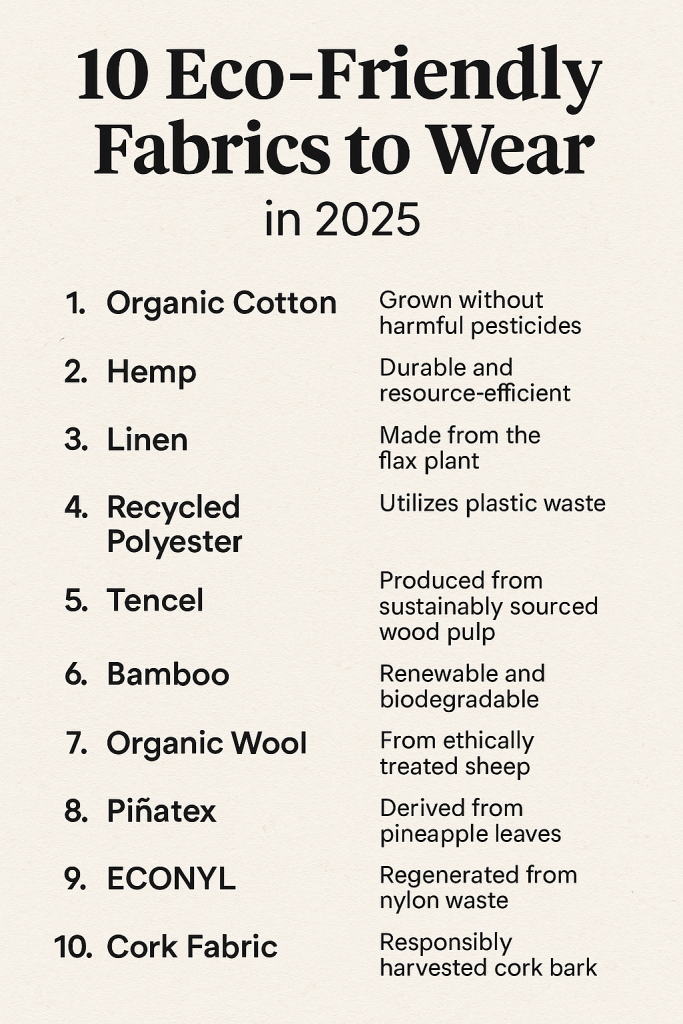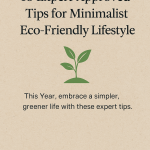🧵 A Personal Insight: My Closet Was “Green”—But Not Really
A few years ago, I proudly called my wardrobe sustainable. I used tote bags, shopped secondhand, and avoided fast fashion when I could. But then I started reading fabric labels… and realized I didn’t understand what I was actually wearing.
That comfy “bamboo” shirt? Heavily processed with chemicals. The “organic” cotton pants? Blended with polyester.
That’s when I dove deep into understanding eco-friendly fabrics—and how sustainable fashion starts at the fiber level.
Here are 10 expert-backed tips to help you make better, greener fashion choices in 2025.

🌿 Why Fabric Choice Matters
- 🏭 Textile production contributes to ~10% of global carbon emissions
- 🌊 Over 500,000 tons of microplastics enter oceans every year from synthetic fabrics
- 🧴 Polyester, nylon, and acrylic = plastic-based materials derived from petroleum
Choosing eco-friendly fabrics is one of the simplest, most powerful ways to reduce your wardrobe’s impact.
✅ Tip 1: Choose Natural Fibers First
Whenever possible, choose organic, unblended, natural fabrics such as:
- Organic cotton (GOTS certified)
- Linen (made from flax, requires minimal water)
- Hemp (fast-growing, pest-resistant)
- Tencel / Lyocell (wood pulp processed in closed-loop systems)
- Ramie (similar to linen, strong & breathable)
✅ Tip 2: Learn the Difference Between “Bamboo” and “Bamboo Rayon”
Not all bamboo is created equal.
Raw bamboo fabric is rare and sustainable. But most “bamboo” clothes are rayon or viscose, made with toxic solvents.
🧠 Look for: “Lyocell from bamboo” or certified closed-loop bamboo processing.
🚫 Avoid: Generic “bamboo” claims with no backing.
✅ Tip 3: Prioritize Certifications
Look for third-party certifications that verify sustainable sourcing:
- GOTS (Global Organic Textile Standard)
- OEKO-TEX® (tested for harmful substances)
- Cradle to Cradle Certified™
- bluesign® Approved
- Fair Trade Certified
Check out Good On You to find certified ethical brands.
✅ Tip 4: Opt for Undyed, Low-Impact Dyes, or Natural Dyes
Fabric dyeing is one of the most polluting processes in fashion.
Choose:
- Undyed / naturally colored fibers (e.g. color-grown cotton)
- Plant-based dyes or low-impact synthetic dyes
- Brands that disclose water-saving, non-toxic dye methods
🎨 Try natural-dye brands like Tonlé or Christy Dawn.
✅ Tip 5: Avoid Blends (If You Want to Recycle It Later)
Many clothes are made from cotton-polyester or nylon blends. These:
- Cannot be recycled in standard textile programs
- Often reduce breathability
- Increase microplastic shedding
Stick with 100% natural fabrics where possible.
✅ Tip 6: Understand the Lifecycle of the Fabric
Think beyond the purchase:
- Is it biodegradable?
- Can you compost it at the end of its life?
- Will it shed microfibers in the wash?
🧼 Use a Guppyfriend bag or Cora Ball in your laundry to reduce fiber pollution from any synthetics you own.
✅ Tip 7: Try Regenerative or Deadstock Materials
🌾 Regenerative agriculture is being used to grow cotton and hemp with better soil outcomes.
🧵 Deadstock fabric is surplus fabric from fashion houses, diverted from landfills.
Check out brands like The Renewal Workshop or Reformation using deadstock.
✅ Tip 8: Prioritize Breathability and Durability
Eco-friendliness is not only about origin—it’s also about how long it lasts.
Choose fabrics that:
- Don’t pill easily
- Maintain shape after multiple washes
- Require less washing (e.g. wool)
- Age beautifully (linen gets softer over time)
✅ Tip 9: Don’t Be Fooled by Greenwashing
Terms like “eco,” “natural,” or “green” are not regulated.
Read the label. Research the brand. Ask:
- Where was it made?
- Is the sourcing transparent?
- Are there independent certifications?
🧠 Use Good On You or Remake World to verify claims.
✅ Tip 10: Buy Less, Choose Well, Care More
Sometimes the most sustainable outfit is the one you already own.
👕 Extend the life of your clothes with:
- Gentle washing
- Air drying
- Repairing minor damage
- Swapping with friends or thrifting
📋 Quick Reference: Best Eco-Friendly Fabrics in 2025
| Fabric | Source | Pros | Best Use |
|---|---|---|---|
| Organic Cotton | Plant (GOTS) | Soft, breathable, widely used | T-shirts, underwear |
| Linen | Flax plant | Durable, biodegradable | Shirts, pants |
| Hemp | Hemp plant | Fast-growing, low impact | Denim, bags |
| Tencel | Wood pulp | Closed-loop process, silky | Dresses, sleepwear |
| Ramie | Nettle family | Strong, moisture-wicking | Lightweight wear |
💬 FAQ – Eco Friendly Fabrics to Wear
1. What is the most sustainable fabric in 2025?
Hemp, organic cotton, and Tencel are considered top-tier for environmental performance.
2. Is recycled polyester eco-friendly?
It reduces landfill waste, but still sheds microplastics and isn’t biodegradable.
3. Is linen really better than cotton?
Yes—linen uses far less water and no pesticides. It also lasts longer.
4. What’s the downside of synthetic blends?
Difficult to recycle, less breathable, and shed plastic microfibers.
5. Can I compost my old clothes?
Only if they are 100% natural, undyed or dyed with plant-based dyes, and free from plastic threads or prints.
💡 Final Thought: You Wear What You Believe
Your wardrobe is your billboard. What you wear tells a story.
Let’s make that story one of:
- Responsibility
- Beauty with purpose
- Style without waste
🛒 Try this today:
Flip through your wardrobe and check 3 fabric labels. Google them. Learn something.
Then… decide what you’ll choose next.
📩 Subscribe to Hazel’s Green Life for weekly sustainable fashion inspiration!
